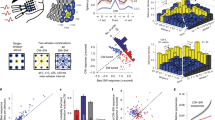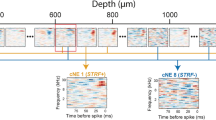Abstract
As in other sensory modalities, one function of the somatosensory system is to detect coherence and contrast in the environment. To investigate the neural bases of these computations, we applied different spatiotemporal patterns of stimuli to rat whiskers while recording multiple neurons in the barrel cortex. Model-based analysis of the responses revealed different coding schemes according to the level of input correlation. With uncorrelated stimuli on 24 whiskers, we identified two distinct functional categories of neurons, analogous in the temporal domain to simple and complex cells of the primary visual cortex. With correlated stimuli, however, a complementary coding scheme emerged: two distinct cell populations, similar to reinforcing and antagonist neurons described in the higher visual area MT, responded specifically to correlations. We suggest that similar context-dependent coexisting coding strategies may be present in other sensory systems to adapt sensory integration to specific stimulus statistics.
This is a preview of subscription content, access via your institution
Access options
Subscribe to this journal
Receive 12 print issues and online access
$209.00 per year
only $17.42 per issue
Buy this article
- Purchase on Springer Link
- Instant access to full article PDF
Prices may be subject to local taxes which are calculated during checkout







Similar content being viewed by others
References
Carvell, G.E. & Simons, D.J. Biometric analyses of vibrissal tactile discrimination in the rat. J. Neurosci. 10, 2638–2648 (1990).
Simons, D.J. Response properties of vibrissa units in rat SI somatosensory neocortex. J. Neurophysiol. 41, 798–820 (1978).
Brecht, M. & Sakmann, B. Dynamic representation of whisker deflection by synaptic potentials in spiny stellate and pyramidal cells in the barrels and septa of layer 4 rat somatosensory cortex. J. Physiol. (Lond.) 543, 49–70 (2002).
Moore, C.I. & Nelson, S.B. Spatio-temporal subthreshold receptive fields in the vibrissa representation of rat primary somatosensory cortex. J. Neurophysiol. 80, 2882–2892 (1998).
Wilent, W.B. & Contreras, D. Dynamics of excitation and inhibition underlying stimulus selectivity in rat somatosensory cortex. Nat. Neurosci. 8, 1364–1370 (2005).
Hartmann, M.J., Johnson, N.J., Towal, R.B. & Assad, C. Mechanical characteristics of rat vibrissae: resonant frequencies and damping in isolated whiskers and in the awake behaving animal. J. Neurosci. 23, 6510–6519 (2003).
Ritt, J.T., Andermann, M.L. & Moore, C.I. Embodied information processing: vibrissa mechanics and texture features shape micromotions in actively sensing rats. Neuron 57, 599–613 (2008).
Ego-Stengel, V., Souza, T.M., Jacob, V. & Shulz, D.E. Spatiotemporal characteristics of neuronal sensory integration in the barrel cortex of the rat. J. Neurophysiol. 93, 1450–1467 (2005).
Shimegi, S., Ichikawa, T., Akasaki, T. & Sato, H. Temporal characteristics of response integration evoked by multiple whisker stimulations in the barrel cortex of rats. J. Neurosci. 19, 10164–10175 (1999).
Simons, D.J. & Carvell, G.E. Thalamocortical response transformation in the rat vibrissa/barrel system. J. Neurophysiol. 61, 311–330 (1989).
Ghazanfar, A.A. & Nicolelis, M.A. Spatiotemporal properties of layer V neurons of the rat primary somatosensory cortex. Cereb. Cortex 9, 348–361 (1999).
Hirata, A. & Castro-Alamancos, M.A. Cortical transformation of wide-field (multiwhisker) sensory responses. J. Neurophysiol. 100, 358–370 (2008).
Mirabella, G., Battiston, S. & Diamond, M.E. Integration of multiple-whisker inputs in rat somatosensory cortex. Cereb. Cortex 11, 164–170 (2001).
Brumberg, J.C., Pinto, D.J. & Simons, D.J. Spatial gradients and inhibitory summation in the rat whisker barrel system. J. Neurophysiol. 76, 130–140 (1996).
Schwartz, O., Pillow, J.W., Rust, N.C. & Simoncelli, E.P. Spike–triggered neural characterization. J. Vis. 6, 484–507 (2006).
de Ruyter van Steveninck, R. & Bialek, W. Real-time performance of a movement-sensitive neuron in the blowfly visual system: coding and information transfer in short spike sequences. Proc. R. Soc. Lond. B Biol. Sci. 234, 379–414 (1988).
de Kock, C.P. & Sakmann, B. Spiking in primary somatosensory cortex during natural whisking in awake head-restrained rats is cell-type specific. Proc. Natl. Acad. Sci. USA 106, 16446–16450 (2009).
Geffen, M.N., Broome, B.M., Laurent, G. & Meister, M. Neural encoding of rapidly fluctuating odors. Neuron 61, 570–586 (2009).
Maravall, M., Petersen, R.S., Fairhall, A.L., Arabzadeh, E. & Diamond, M.E. Shifts in coding properties and maintenance of information transmission during adaptation in barrel cortex. PLoS Biol. 5, e19 (2007).
Skottun, B.C. et al. Classifying simple and complex cells on the basis of response modulation. Vision Res. 31, 1079–1086 (1991).
Pettigrew, J.D., Nikara, T. & Bishop, P. Responses to moving slits by single units in cat striate cortex. Exp. Brain Res. 6, 373–390 (1968).
Lee, S.H. & Simons, D. Angular tuning and velocity sensitivity in different neuron classes within layer 4 of rat barrel cortex. J. Neurophysiol. 91, 223–229 (2004).
Ghazanfar, A.A. & Nicolelis, M.A. Nonlinear processing of tactile information in the thalamocortical loop. J. Neurophysiol. 78, 506–510 (1997).
Born, R.T. & Tootell, R.B. Segregation of global and local motion processing in primate middle temporal visual area. Nature 357, 497–499 (1992).
Jadhav, S.P., Wolfe, J. & Feldman, D.E. Sparse temporal coding of elementary tactile features during active whisker sensation. Nat. Neurosci. 12, 792–800 (2009).
Shimegi, S., Akasaki, T., Ichikawa, T. & Sato, H. Physiological and anatomical organization of multi-whisker response interactions in the barrel cortex of rats. J. Neurosci. 20, 6241–6248 (2000).
Simons, D.J. Temporal and spatial integration in the rat SI vibrissa cortex. J. Neurophysiol. 54, 615–635 (1985).
Jacob, V., Cam, J.L., Ego-Stengel, V. & Shulz, D.E. Emergent properties of tactile scenes selectively activate barrel cortex neurons. Neuron 60, 1112–1125 (2008).
Born, R.T. Center–surround interactions in the middle temporal visual area of the owl monkey. J. Neurophysiol. 84, 2658–2669 (2000).
Sincich, L.C., Park, K.F., Wohlgemuth, M.J. & Horton, J.C. Bypassing V1: a direct geniculate input to area MT. Nat. Neurosci. 7, 1123–1128 (2004).
Pei, Y.C., Hsiao, S.S. & Bensmaia, S.J. The tactile integration of local motion cues is analogous to its visual counterpart. Proc. Natl. Acad. Sci. USA 105, 8130–8135 (2008).
Pei, Y.-C., Hsiao, S.S., Craig, J.C. & Bensmaia, S.J. Neural mechanisms of tactile motion integration in somatosensory cortex. Neuron 69, 536–547 (2011).
Ferezou, I. et al. Spatiotemporal dynamics of cortical sensorimotor integration in behaving mice. Neuron 56, 907–923 (2007).
Matyas, F. et al. Motor control by sensory cortex. Science 330, 1240–1243 (2010).
Jones, H.E., Wang, W. & Sillito, A.M. Spatial organization and magnitude of orientation contrast interactions in primate V1. J. Neurophysiol. 88, 2796–2808 (2002).
Newsome, W.T., Wurtz, R.H., Dürsteler, M.R. & Mikami, A. Deficits in visual motion processing following ibotenic acid lesions of the middle temporal visual area of the macaque monkey. J. Neurosci. 5, 825–840 (1985).
Rust, N.C., Schwartz, O., Movshon, J.A. & Simoncelli, E.P. Spatiotemporal elements of macaque v1 receptive fields. Neuron 46, 945–956 (2005).
Ego-Stengel, V., Le Cam, J. & Shulz, D.E. Coding of apparent motion in the thalamic nucleus of the rat vibrissal somatosensory system. J. Neurosci. 32, 3339–3351 (2012).
Aguilar, J.R. & Castro-Alamancos, M. Spatiotemporal gating of sensory inputs in thalamus during quiescent and activated states. J. Neurosci. 25, 10990–11002 (2005).
Roy, N.C., Bessaih, T. & Contreras, D. Comprehensive mapping of whisker-evoked responses reveals broad, sharply tuned thalamocortical input to layer 4 of barrel cortex. J. Neurophysiol. 105, 2421–2437 (2011).
Petersen, R.S. et al. Diverse and temporally precise kinetic feature selectivity in the VPm thalamic nucleus. Neuron 60, 890–903 (2008).
Le Cam, J., Estebanez, L., Jacob, V. & Shulz, D.E. Spatial structure of multi-whisker receptive fields in the barrel cortex is stimulus dependent. J. Neurophysiol. 106, 986–998 (2011).
Zhu, J.J. & Connors, B.W. Intrinsic firing patterns and whisker-evoked synaptic responses of neurons in the rat barrel cortex. J. Neurophysiol. 81, 1171–1183 (1999).
Touryan, J., Felsen, G. & Dan, Y. Spatial structure of complex cell receptive fields measured with natural images. Neuron 45, 781–791 (2005).
Friedberg, M.H., Lee, S.M. & Ebner, F.F. Modulation of receptive field properties of thalamic somatosensory neurons by the depth of anesthesia. J. Neurophysiol. 81, 2243–2252 (1999).
Jacob, V. et al. The Matrix: a new tool for probing the whisker-to-barrel system with natural stimuli. J. Neurosci. Methods 189, 65–74 (2010).
Wolfe, J. et al. Texture coding in the rat whisker system: slip-stick versus differential resonance. PLoS Biol. 6, e215 (2008).
DiCarlo, J.J., Lane, J.W., Hsiao, S.S. & Johnson, K.O. Marking microelectrode penetrations with fluorescent dyes. J. Neurosci. Methods 64, 75–81 (1996).
Cardona, A. et al. An integrated micro- and macroarchitectural analysis of the Drosophila brain by computer-assisted serial section electron microscopy. PLoS Biol. 8, e1000502 (2010).
Smyth, D., Willmore, B., Baker, G.E., Thompson, I.D. & Tolhurst, D.J. The receptive-field organization of simple cells in primary visual cortex of ferrets under natural scene stimulation. J. Neurosci. 23, 4746–4759 (2003).
Acknowledgements
We thank Y. Boubenec for providing the natural whisker stimuli, L. Abbott, L. Bourdieu, A. Davison, V. Ego-Stengel, Y. Frégnac, O. Marre, M. Maravall and H. Sompolinsky for comments on the manuscript, and J. Fournier for advice on the protocol. Funding was provided by ANR (NATACS, HR-CORTEX and TRANSTACT) and the European Community (FET grants FACETS FP6-015879, BrainScaleS FP7-269921 and Brain-i-Nets FP7-243914). S.E.B. was supported by Fondation pour la Recherche Medicale.
Author information
Authors and Affiliations
Contributions
L.E. and S.E.B. devised the protocols and analyzed the data with D.E.S. and A.D. L.E. and S.E.B. carried out the extracellular recordings. D.E.S. and A.D. supervised the research. L.E., S.E.B., A.D. and D.E.S. wrote the manuscript.
Corresponding authors
Ethics declarations
Competing interests
The authors declare no competing financial interests.
Supplementary information
Supplementary Text and Figures
Supplementary Figures 1–12 and Supplementary Table 1 (PDF 3444 kb)
Rights and permissions
About this article
Cite this article
Estebanez, L., Boustani, S., Destexhe, A. et al. Correlated input reveals coexisting coding schemes in a sensory cortex. Nat Neurosci 15, 1691–1699 (2012). https://doi.org/10.1038/nn.3258
Received:
Accepted:
Published:
Issue Date:
DOI: https://doi.org/10.1038/nn.3258
This article is cited by
-
Tuning instability of non-columnar neurons in the salt-and-pepper whisker map in somatosensory cortex
Nature Communications (2022)
-
Learning enhances encoding of time and temporal surprise in mouse primary sensory cortex
Nature Communications (2022)
-
Anatomically and functionally distinct thalamocortical inputs to primary and secondary mouse whisker somatosensory cortices
Nature Communications (2020)
-
Elementary motion sequence detectors in whisker somatosensory cortex
Nature Neuroscience (2019)
-
Sensorimotor processing in the rodent barrel cortex
Nature Reviews Neuroscience (2019)



